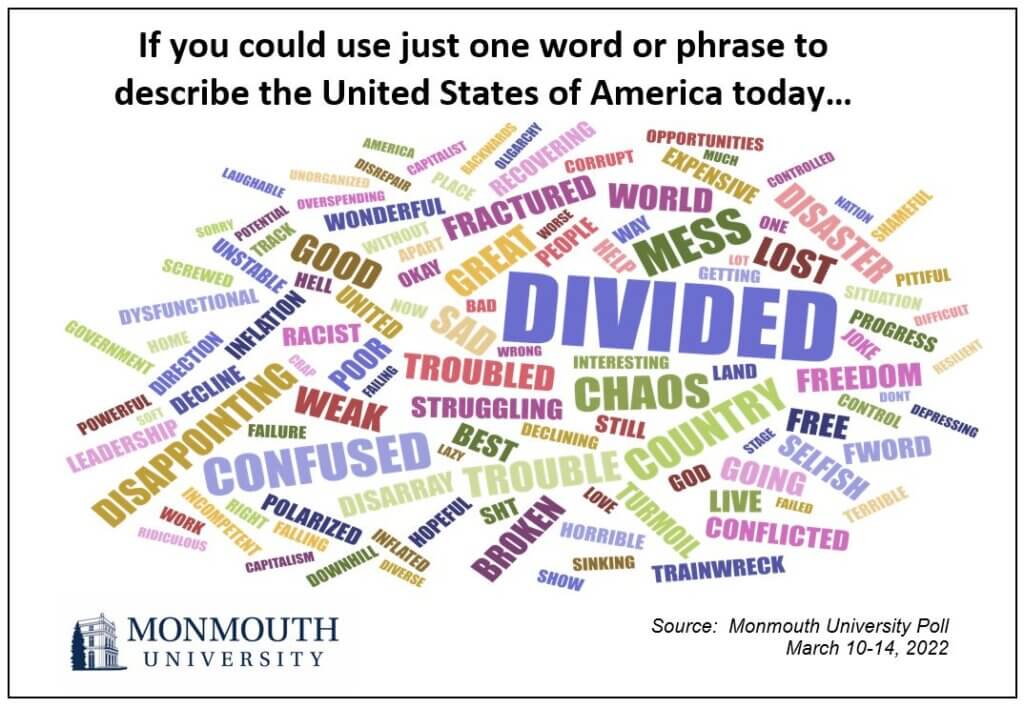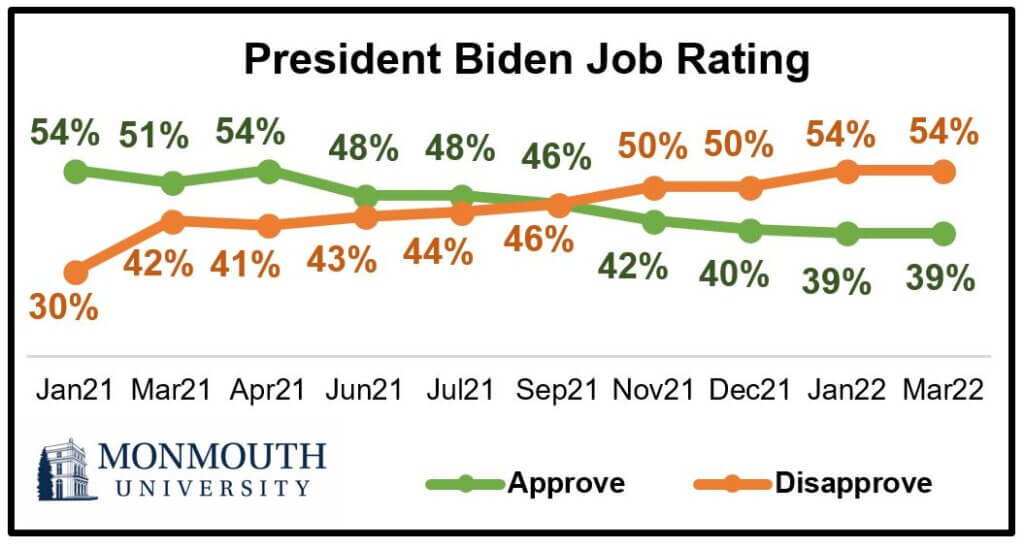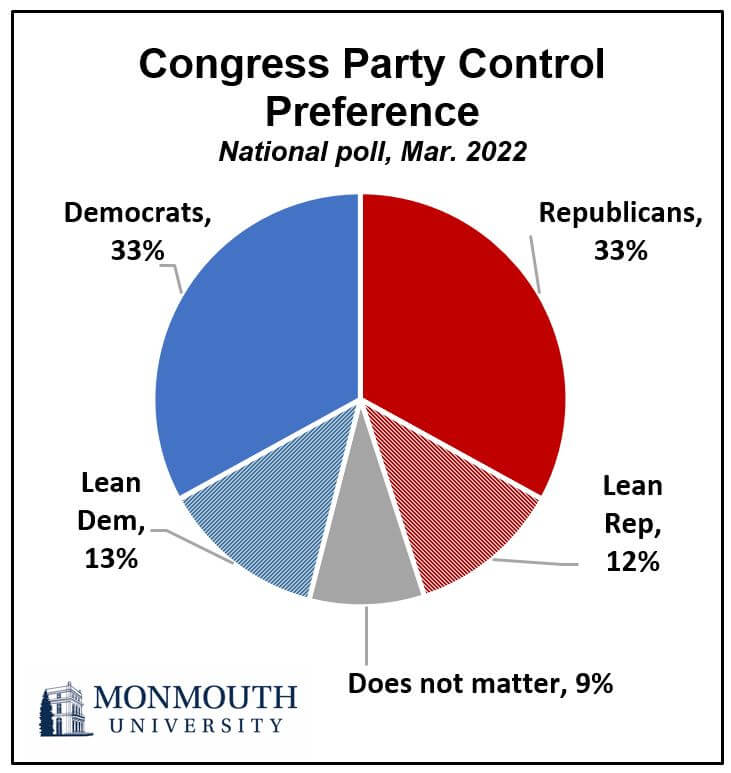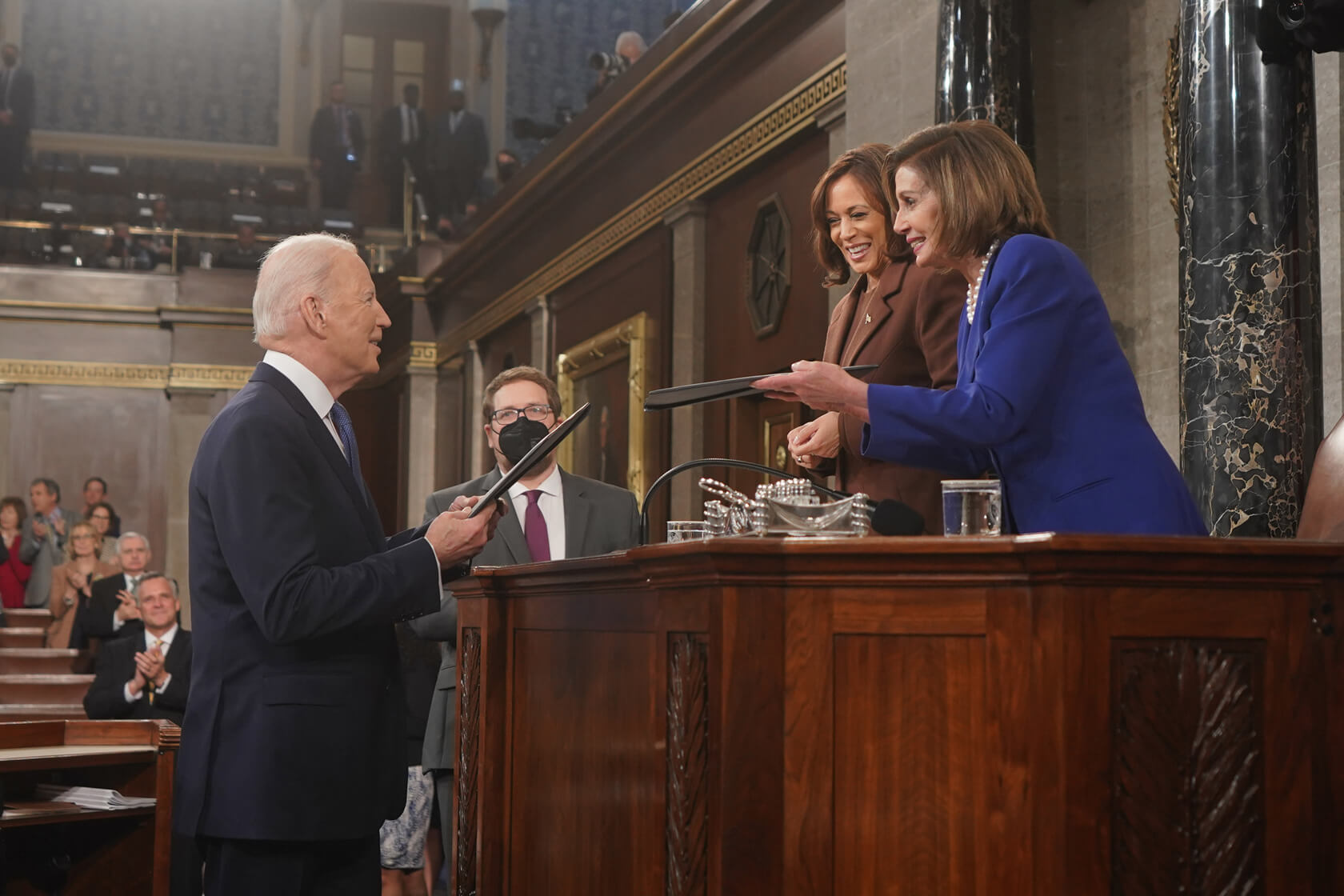West Long Branch, NJ – Divided. That is the most commonly mentioned description of the country today, according to the Monmouth (“Mon-muth”) University Poll. Less than half of the public feels that the state of the union is strong. Americans express much less optimism about President Joe Biden now than at the start of his term just over a year ago. Just 1 in 4 say his first year agenda has put a lot of focus on issues important to average Americans.
Less than half (46%) of the American public says the state of the union is strong (8% very and 38% somewhat). Another 27% say it is not too strong and 24% say it is not at all strong. This result is more negative than in a poll taken after former President Donald Trump’s first year in office (55% strong in January 2018) although that number declined by the following year (48% strong in January 2019). Compared to four years ago, Republicans have shown a bigger shift in opinion that the union is strong (from 76% in 2018 to 24% now) than Democrats have (from 42% to 68%). Opinion among independents has been more stable (52% strong in 2018 and 46% in 2022). Overall, just 24% of the public feels that the country is headed in the right direction. This number hit a high of 46% last April before steadily declining over the past year. The “right direction” poll number hovered between 18% and 40% during the Trump administration.
“The country is seen as a little less strong than it was four years ago, although that opinion was fleeting. At the same time, fewer Americans feel we are becoming more divided than we have been over the past few years, but this disunity remains the dominant image of the state of the country,” said Patrick Murray, director of the independent Monmouth University Polling Institute.
Nearly half of Americans (48%) say the country has become more divided since Biden took office. Just 15% say it has become more united and 35% say it has not really changed. Throughout most of Trump’s term in office, about two-thirds of the public felt the country had become more divided. When Monmouth asked poll respondents to use one word or phrase to describe the United States of America today, the most common response was “divided” (see word cloud image). This sentiment accounts for more than 1 in 10 responses when combined with related words such as polarized, conflicted, and fractured. Other commonly mentioned top-of-mind words are chaos, mess, confused, and disappointing. In all, 76% of poll respondents used a negative word to describe the current state of the country while just 15% used a positive one.

President Biden currently holds a job performance rating of 39% approve and 54% disapprove, which is unchanged from January. This comes at the same time he receives a split decision on his handling of the Ukraine crisis. Trump had an identical 39% to 54% job rating at the same point in his term (March 2018) – which was down slightly from 42% to 50% in January 2018, shortly after passage of his signature tax reform plan.
Overall, 26% say that Biden’s first year agenda has focused a lot on issues important to average Americans, 38% say it has focused a little on these issues, and 35% say it has not focused at all on the concerns of average Americans. Trump did somewhat better on this metric (37% a lot, 34% a little, and 26% not at all in January 2018).
Just 38% of Americans feel optimistic about the policies Biden will pursue over the next few years, which is down significantly from 61% who felt optimistic as he took office last year. By comparison, 50% were optimistic about Trump’s policy agenda both when he first took office and a year into his term. Four in ten Americans (41%) feel very pessimistic right now about the policies Biden will pursue, which is more negative than it was a year ago (26%) as well as the same metric for Trump one year into his term (31%).
“Arguably, Biden has scored more legislative successes than Trump did a year into his presidency, but he has also suffered high profile defeats. In the end, there was relatively more optimism about Biden than Trump and thus greater expectations about what he could accomplish. That’s one reason we are seeing some lack of enthusiasm now, particularly among the president’s base,” said Murray.
Just under half of the American public (48%) feels Biden has been at least somewhat successful at getting Congress to pass his legislative agenda, while an identical number say he has not been all that successful (48%). On the heels of his tax reform achievement, impressions of Trump’s legislative ability in early 2018 stood at 55% successful and 41% not successful (which was a marked improvement from 42% successful and 53% not in December 2017). Currently, 63% of Democrats feel Biden has been successful working with Congress. In January 2018, 77% of Republicans felt the same about Trump.

The Monmouth poll also asked about the impact of recent increases in the price of gas. Just under 4 in 10 Americans (38%) say that rising gas prices have caused them a great deal of financial hardship. Another 30% say it has caused them some hardship, while 18% say they have not experienced much hardship due to gas prices and 14% say this has not impacted them at all. Those earning less than $50,000 a year are somewhat more likely to say rising gas prices have caused them a great deal of financial hardship – 44%, compared with 37% for those earning $50 to $100,000 and 27% for those earning over $100,000. There is an even greater divergence in self-reported hardship by partisanship – 61% great deal among Republicans versus 32% among independents and 21% among Democrats.
It is also worth noting that rising pump prices have had little impact so far on the public’s support for banning Russian gas and oil imports, as Monmouth reported yesterday. Fully 72% of those who say they have suffered a great deal of financial hardship from rising gas prices support the import ban, which is not much different from support among other Americans (82%).
Turning to this year’s midterm elections, the public is evenly split between preferring to have the Republicans (33%) or the Democrats (33%) in control of Congress. Pushing those who initially say party control does not matter on which direction they lean adds 12% to the GOP column and 13% for the Democrats. The GOP’s combined 45% support level is down slightly from 50% in January, while the Democrats’ 46% combined support is up slightly from 43%. Just over half of the public (56%) says it is very important to have their preferred party in control of Congress, which is similar to 54% in January. The current congressional control importance rating is slightly higher among those who want Republican (64%) rather than Democratic (59%) leadership. In January, this metric was slightly higher for Democratic (61%) than Republican (56%) control. Overall, just 21% of the public approves of the job Congress is currently doing, while 71% disapprove.

The Monmouth University Poll was conducted by telephone from March 10 to 14, 2022 with 809 adults in the United States. The question results in this release have a margin of error of +/- 3.5 percentage points. The poll was conducted by the Monmouth University Polling Institute in West Long Branch, NJ.
QUESTIONS AND RESULTS
(* Some columns may not add to 100% due to rounding.)
1.Do you approve or disapprove of the job Joe Biden is doing as president?
| TREND: | March 2022 | Jan. 2022 | Dec. 2021 | Nov. 2021 | Sept. 2021 | July 2021 | June 2021 | April 2021 | March 2021 | Jan. 2021 |
| Approve | 39% | 39% | 40% | 42% | 46% | 48% | 48% | 54% | 51% | 54% |
| Disapprove | 54% | 54% | 50% | 50% | 46% | 44% | 43% | 41% | 42% | 30% |
| (VOL) No opinion | 7% | 7% | 11% | 9% | 8% | 8% | 9% | 5% | 8% | 16% |
| (n) | (809) | (794) | (808) | (811) | (802) | (804) | (810) | (800) | (802) | (809) |
2.Do you approve or disapprove of the job the U.S. Congress is doing?
| TREND: | March 2022 | Jan. 2022 | Dec. 2021 | Nov. 2021 | Sept. 2021 | July 2021 | June 2021 | April 2021 | March 2021 | Jan. 2021 |
| Approve | 21% | 19% | 23% | 18% | 22% | 23% | 21% | 35% | 30% | 35% |
| Disapprove | 71% | 74% | 66% | 70% | 65% | 62% | 65% | 56% | 59% | 51% |
| (VOL) No opinion | 8% | 6% | 11% | 12% | 13% | 15% | 15% | 9% | 11% | 14% |
| (n) | (809) | (794) | (808) | (811) | (802) | (804) | (810) | (800) | (802) | (809) |
| TREND: Continued | Nov. 2020 | Early June 2020 | May 2020 | April 2020 | Feb. 2020 | Jan. 2020 | Dec. 2019 | Nov. 2019 | Sept. 2019 | Aug. 2019 | June 2019 | May 2019 | April 2019 | March 2019 | Jan. 2019 |
| Approve | 23% | 22% | 32% | 32% | 20% | 24% | 22% | 23% | 21% | 17% | 19% | 20% | 24% | 23% | 18% |
| Disapprove | 64% | 69% | 55% | 55% | 69% | 62% | 65% | 64% | 68% | 71% | 69% | 71% | 62% | 68% | 72% |
| (VOL) No opinion | 13% | 9% | 13% | 13% | 11% | 14% | 13% | 13% | 11% | 13% | 12% | 9% | 14% | 9% | 10% |
| (n) | (810) | (807) | (808) | (857) | (902) | (903) | (903) | (908) | (1,161) | (800) | (751) | (802) | (801) | (802) | (805) |
| TREND: Continued | Nov. 2018 | Aug. 2018 | June 2018 | April 2018 | March 2018 | Jan. 2018 | Dec. 2017 | Sept. 2017 | Aug. 2017 | July 2017 | May 2017 | March 2017 | Jan. 2017 |
| Approve | 23% | 17% | 19% | 17% | 18% | 21% | 16% | 17% | 18% | 19% | 19% | 25% | 23% |
| Disapprove | 63% | 69% | 67% | 71% | 72% | 68% | 65% | 69% | 69% | 70% | 68% | 59% | 66% |
| (VOL) No opinion | 14% | 14% | 14% | 12% | 11% | 11% | 19% | 15% | 13% | 11% | 13% | 16% | 11% |
| (n) | (802) | (805) | (806) | (803) | (803) | (806) | (806) | (1,009) | (805) | (800) | (1,002) | (801) | (801) |
| TREND: Continued | Sept. 2016* | Aug. 2016* | June 2016* | March 2016 | Jan. 2016 | Dec. 2015 | Oct. 2015 | Sept. 2015 | Aug. 2015 | July 2015 | June 2015 | April 2015 | Jan. 2015 | Dec. 2014 | July 2013 |
| Approve | 15% | 14% | 17% | 22% | 17% | 16% | 17% | 19% | 18% | 18% | 19% | 21% | 18% | 17% | 14% |
| Disapprove | 77% | 78% | 76% | 68% | 73% | 73% | 71% | 71% | 72% | 69% | 71% | 67% | 70% | 73% | 76% |
| (VOL) No opinion | 8% | 9% | 7% | 10% | 10% | 10% | 12% | 11% | 11% | 12% | 10% | 12% | 11% | 11% | 10% |
| (n) | (802) | (803) | (803) | (1,008) | (1,003) | (1,006) | (1,012) | (1,009) | (1,203) | (1,001) | (1,002) | (1,005) | (1,003) | (1,008) | (1,012) |
* Registered voters
3.Would you rather see the Republicans or the Democrats in control of Congress, or doesn’t this matter to you? [CHOICES WERE ROTATED] [If DOES NOT MATTER: If you had to lean one way or the other would you pick the Republicans or the Democrats?]
| TREND: | March 2022 | Jan. 2022 |
| Republicans | 33% | 35% |
| Not matter, but lean Rep | 12% | 15% |
| Democrats | 33% | 33% |
| Not matter, but lean Dem | 13% | 10% |
| Does not matter, no lean | 9% | 7% |
| (VOL) Don’t know | 1% | 0% |
| (n) | (809) | (794) |
4.Is it very important, somewhat important, or only a little important to have [Republicans/Democrats] in control of Congress? [CHOICE READ FROM Q3]
| TREND: | March 2022 | Jan. 2022 |
| Very important | 56% | 54% |
| Somewhat important | 21% | 23% |
| Only a little important | 12% | 15% |
| (VOL) Don’t know / Does not matter who controls Congress (from Q3) | 11% | 8% |
| (n) | (809) | (794) |
5.Would you say things in the country are going in the right direction, or have they gotten off on the wrong track?
| TREND: | March 2022 | Jan. 2022 | Dec. 2021 | Nov. 2021 | Sept. 2021 | July 2021 | June 2021 | April 2021 | March 2021 | Jan. 2021 |
| Right direction | 24% | 24% | 30% | 31% | 29% | 38% | 37% | 46% | 34% | 42% |
| Wrong track | 73% | 71% | 66% | 64% | 65% | 56% | 57% | 50% | 61% | 51% |
| (VOL) Depends | 1% | 3% | 1% | 2% | 4% | 3% | 3% | 2% | 4% | 3% |
| (VOL) Don’t know | 2% | 2% | 3% | 3% | 2% | 4% | 3% | 2% | 2% | 4% |
| (n) | (809) | (794) | (808) | (811) | (802) | (804) | (810) | (800) | (802) | (809) |
| TREND: Continued | Nov. 2020 | Early Sept. 2020 | Aug. 2020 | Late June 2020 | Early June 2020 | May 2020 | April 2020 | March 2020 | Feb. 2020 | Jan. 2020 |
| Right direction | 26% | 27% | 22% | 18% | 21% | 33% | 30% | 39% | 37% | 37% |
| Wrong track | 68% | 66% | 72% | 74% | 74% | 60% | 61% | 54% | 57% | 56% |
| (VOL) Depends | 4% | 4% | 4% | 5% | 4% | 4% | 5% | 4% | 6% | 6% |
| (VOL) Don’t know | 2% | 3% | 2% | 3% | 1% | 3% | 5% | 3% | 1% | 1% |
| (n) | (810) | (867) | (868) | (867) | (807) | (808) | (857) | (851) | (902) | (903) |
| TREND: Continued | Dec. 2019 | Nov. 2019 | Sept. 2019 | Aug. 2019 | June 2019 | May 2019 | April 2019 | March 2019 | Nov. 2018 | Aug. 2018 | June 2018 | April 2018 | March 2018 | Jan. 2018 |
| Right direction | 32% | 30% | 30% | 28% | 31% | 29% | 28% | 29% | 35% | 35% | 40% | 33% | 31% | 37% |
| Wrong track | 56% | 61% | 61% | 62% | 62% | 63% | 62% | 63% | 55% | 57% | 53% | 58% | 61% | 57% |
| (VOL) Depends | 8% | 7% | 6% | 8% | 6% | 4% | 7% | 6% | 7% | 6% | 3% | 5% | 6% | 3% |
| (VOL) Don’t know | 4% | 2% | 2% | 2% | 2% | 3% | 3% | 2% | 3% | 3% | 3% | 4% | 1% | 3% |
| (n) | (903) | (908) | (1,161) | (800) | (751) | (802) | (801) | (802) | (802) | (805) | (806) | (803) | (803) | (806) |
| TREND: Continued | Dec. 2017 | Aug. 2017 | May 2017 | March 2017 | Jan. 2017 | Aug. 2016* | Oct. 2015 | July 2015 | June 2015 | April 2015 | Dec. 2014 | July 2013 |
| Right direction | 24% | 32% | 31% | 35% | 29% | 30% | 24% | 28% | 23% | 27% | 23% | 28% |
| Wrong track | 66% | 58% | 61% | 56% | 65% | 65% | 66% | 63% | 68% | 66% | 69% | 63% |
| (VOL) Depends | 7% | 4% | 5% | 4% | 4% | 2% | 6% | 5% | 5% | 5% | 5% | 5% |
| (VOL) Don’t know | 3% | 5% | 3% | 5% | 2% | 3% | 4% | 3% | 3% | 2% | 3% | 4% |
| (n) | (806) | (805) | (1,002) | (801) | (801) | (803) | (1,012) | (1,001) | (1,002) | (1,005) | (1,008) | (1,012) |
* Registered voters
6.If you could use just one word or phrase to describe the United States of America today, what would it be?
[See word cloud in report text.]
7.Would you say the state of the union is very strong, somewhat strong, not too strong, or not at all strong?
| TREND: | March 2022 | Jan. 2019 | Jan. 2018 |
| Very strong | 8% | 13% | 13% |
| Somewhat strong | 38% | 35% | 42% |
| Not too strong | 27% | 27% | 24% |
| Not at all strong | 24% | 22% | 14% |
| (VOL) Don’t know | 3% | 3% | 6% |
| (n) | (809) | (805) | (806) |
8.Has the country become more united, more divided, or not really changed since President Biden took office?
| TREND: | COMPARISON: Trump | ||||||||
| March 2022 | Nov. 2021 | Nov. 2020 | Late June 2020 | Nov. 2018 | Dec. 2017 | March 2017 | |||
| More united | 15% | 12% | 12% | 13% | 11% | 9% | 11% | ||
| More divided | 48% | 49% | 70% | 66% | 62% | 63% | 52% | ||
| Not really changed | 35% | 38% | 16% | 17% | 25% | 26% | 34% | ||
| (VOL) Don’t know | 1% | 1% | 2% | 4% | 3% | 2% | 3% | ||
| (n) | (809) | (811) | (810) | (867) | (802) | (806) | (801) |
9.How much has Joe Biden’s agenda during his first year in office focused on issues important to average Americans – a lot, a little, or not at all?
| COMPARISON: | Trump | |||
| March 2022 | Jan. 2018 | |||
| A lot | 26% | 37% | ||
| A little | 38% | 34% | ||
| Not at all | 35% | 26% | ||
| (VOL) Don’t know | 2% | 3% | ||
| (n) | (809) | (806) |
10.Thinking about the next few years, do you feel optimistic or pessimistic about the policies Biden will pursue? [Is that very or somewhat optimistic/pessimistic?]
| TREND: | COMPARISON: Expectations for Trump | |||||
| March 2022 | Jan. 2021 | Jan. 2018 | Jan. 2017 | |||
| Very optimistic | 13% | 33% | 29% | 24% | ||
| Somewhat optimistic | 25% | 28% | 21% | 26% | ||
| Somewhat pessimistic | 17% | 9% | 14% | 13% | ||
| Very pessimistic | 41% | 26% | 31% | 30% | ||
| (VOL) Don’t know | 3% | 5% | 4% | 6% | ||
| (n) | (809) | (809) | (806) | (801) |
11.In your view, how successful has President Biden been at getting Congress to pass his legislative agenda – very successful, somewhat successful, not too successful, or not at all successful?
| COMPARISON: | Trump | |||||
| March 2022 | Jan. 2018 | Dec. 2017 | Sept. 2017 | |||
| Very successful | 5% | 7% | 5% | 4% | ||
| Somewhat successful | 43% | 48% | 37% | 32% | ||
| Not too successful | 30% | 25% | 29% | 26% | ||
| Not at all successful | 18% | 16% | 24% | 33% | ||
| (VOL) Don’t know | 5% | 4% | 5% | 4% | ||
| (n) | (809) | (806) | (806) | (1,009) |
12.Have recent increases in gas prices caused you any financial hardship – would you say a great deal, some, not much, or not at all?
| March 2022 | |
| A great deal | 38% |
| Some | 30% |
| Not much | 18% |
| Not at all | 14% |
| (VOL) Don’t know | 0% |
| (n) | (809) |
[Q13-19 & Q30-39 held for future release.]
[Q20-29 & Q40 previously released.]
METHODOLOGY
The Monmouth University Poll was sponsored and conducted by the Monmouth University Polling Institute from March 10 to 14, 2022 with a probability-based national random sample of 809 adults age 18 and older. This includes 278 contacted by a live interviewer on a landline telephone and 531 contacted by a live interviewer on a cell phone, in English. Telephone numbers were selected through a mix of random digit dialing and list-based sampling. Landline respondents were selected with a modified Troldahl-Carter youngest adult household screen. Interviewing services were provided by Braun Research, with sample obtained from Dynata (RDD, n=545), Aristotle (list, n=140) and a panel of prior Monmouth poll participants (n=124). Monmouth is responsible for all aspects of the survey design, data weighting and analysis. The full sample is weighted for region, age, education, gender and race based on US Census information (ACS 2018 one-year survey). For results based on this sample, one can say with 95% confidence that the error attributable to sampling has a maximum margin of plus or minus 3.5 percentage points (unadjusted for sample design). Sampling error can be larger for sub-groups (see table below). In addition to sampling error, one should bear in mind that question wording and practical difficulties in conducting surveys can introduce error or bias into the findings of opinion polls.
| DEMOGRAPHICS (weighted) |
| Self-Reported |
| 29% Republican |
| 43% Independent |
| 28% Democrat |
| 49% Male |
| 51% Female |
| 30% 18-34 |
| 32% 35-54 |
| 38% 55+ |
| 63% White |
| 13% Black |
| 16% Hispanic |
| 8% Asian/Other |
| 70% No degree |
| 30% 4 year degree |
Click on pdf file link below for full methodology and crosstabs by key demographic groups.




